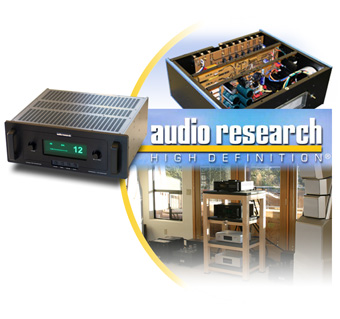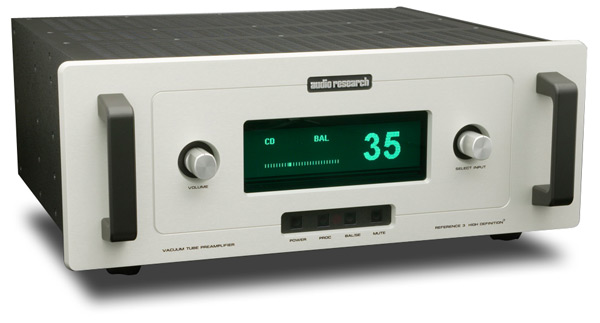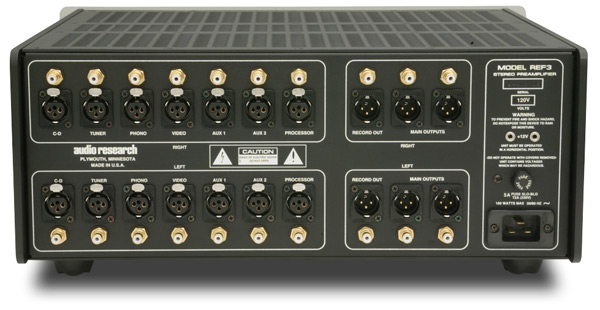![[SoundStage!]](../../titles/sslogo3.gif) Home
Audio Equipment Home
Audio EquipmentFeature Review |
|||||
As I was waiting for the $9995 USD Reference 3 to arrive and the listening to begin, I thought about the preamp that preceded it in Audio Research's Reference product line, the Reference 2 Mk II. I reviewed the Reference 2 Mk II back in 2001, and I enjoyed my time with it for the most part. Its bass, however, which was rich and generous -- "overripe" was the word I used -- made pairing the Reference 2 Mk II with a complementary amp mandatory. At the time, Audio Research made at least one amp that fit the bill -- the VTM200 monoblock -- and together these two parts produced an agreeable whole. However, with Lamm ML2s, my reference amps at the time, the sound of the Reference 2 Mk II was bloated down low. I concluded: "A preamp like the Reference Two Mk II thrives with power, and the Lamms, for all their sonic pluses, just don't offer an abundance of juice." In the scheme of things, however, the mating of the Reference 3 with the ML2.1s is of minor significance. It's one combination among many, and I'm sure, for instance, that many owners of Lamm amps use Lamm preamps, and the same is true for Audio Research owners. It's no surprise that audio companies design their products to be used together. However, in my case, determining if and how the Reference 3 and ML2.1s would work together -- synergize -- was a watershed event because of my earlier experience. The pairing would tell me a lot right from the start. And besides, I was curious. So, immediately after installing the tubes, in went the Reference 3. I won't say that Audio Research addressed what I identified with the Reference 2 Mk II. I wouldn't presume. However, it was clear right from the beginning that the Reference 3's bass was more well behaved than that of the Reference 2 Mk II. Reassured, I set out to discover what the newest Reference preamp had to offer.
"The most coherent preamp from very soft to extremely loud that I've heard. Dynamic coherence." This is the first note I made about the Reference 3's sound, and after months of listening, it is just as relevant. Music played through the Reference 3 is simply louder or softer depending on the preamp's volume setting. Its essential nature doesn't change. This isn't to say that the Reference 3 sounds like it's not there -- it has its identifying marks -- but rather that as the volume goes up or down, the music's character remains consistent. In theory, this is what a preamp is supposed to do, but in practice, it rarely happens. Volume controls affect the signal passed through them; preamps generally sound their best in a certain volume range, often between 11:00 and 1:00. The Reference 3 is immune to this. Loud music sounds like soft music except for the difference in decibels. The entire volume range is the preamp's sweet spot. This uniformity makes for seamless small- and large-scale dynamics. Orchestral crescendos, even the pluck of a single guitar string, happen with a realistic sense of intensity and speed. Instead of jumping from one point to another, music played through the Reference 3 rises or falls with proper gradation, with the information that occurs in between aural events intact. No preamp I've heard does this nearly as well. Another area in which the Reference 3 is without peer is soundstaging, specifically the width of its presentation. It would be easy to say that the Reference 3 places musicians outside the speakers' positions (which it does), but this wouldn't convey how it fills in what happens in between the left and right margins. If you've ever been to the Grand Canyon, you know how different it looks in reality than in a picture or on TV. The first time I went there, I had to acclimate myself to having the view take up my entire range of sight. And this happens each time I visit -- it's the reason I never tire of the Canyon, even after visiting the same overlooks nearly a dozen times. The Reference 3 does this same mesmerizing thing with sound. The entirety of its aural viewpoint is jam-packed with musical data. I'm not referring to detail per se, but rather an aggregate sense of the Reference 3's spatial presentation, which has a truly panoramic sweep. Other preamps convey something similar, but, in their case, it is often an illusion -- a byproduct of a basic forwardness that colors the perspective. They site all music subjectively closer to the listener -- too close for the sake of realism and comfort. Not the Reference 3, whose perspective is dictated by what's on the recording. With recordings that sound like the lead vocalist has swallowed the microphone, like the wonderful collection of David Bowie covers, The Life Aquatic Studio Sessions Featuring Seu Jorge [Hollywood Records 2061-62476-2], or with recordings that sound like they were laid to tape from a different room, like Tony Overwater's ironically titled Up Close [Turtle Records 713606], the Reference 3 presents them as they are, albeit with a right-to-left spread that is state of the art yet never seems anything but completely organic. I've played a cut from Up Close at shows, and it sounds vivid only on very detailed, very forward-sounding systems. This is not what the Reference 3 is about. It doesn't embellish the music, and this is what I want from a preamp.
Bass is rich and redolent, very deep, and powerful. It doesn't have the overabundance of the Reference 2 Mk II's low end (thankfully), but it is not spare and uptight either, imparting a bouncy tension to the music that's not strictly accurate. If anything, the Reference 3's low frequencies are an iota or two plentiful, but this does not translate to excess, just a pleasing sense of weight and bloom. In the past, I would have attributed this to the fact that Audio Research wants to sell its amps along with its preamps, but as I pointed out in the first part of this review, ARC's new Reference amps seem to match the Reference 3 strength for strength instead of offsetting some surplus with a matching deficiency. This also makes the Reference 3 sonically compatible with amps from other companies. In fact, I can't think of an amp I've heard in my system that wouldn't work well with the Reference 3, including fast and detailed solid-state amps, rich and sweet tube models, and especially amps that embody all of these traits. It is this last breed of amp with which the Reference 3 will work especially well, the Lamm M1.2 Reference and, I suspect, Atma-Sphere MA-2 Mk III among them. These are products with no obvious tendencies or deficiencies. Yes, the Reference 3 will allow you to hear what a particular amp is doing, but it's for making music, and a similarly high-achieving amp is just the ticket.
Smoothness is no longer the exclusive domain of tube electronics. Many solid-state preamps sound as smooth as their tube counterparts. The Reference 3's sound is unquestionably smooth, even a touch sweet, but never cloying. It's interesting how the sound of tube preamps has evolved: from classically tubey to very much like classic solid state, to tubey again to appease the SET/horn/single-driver crowd. Simultaneously, solid-state preamps have also developed, with many renowned examples currently available sounding soft and gentle -- tube-like, in short. The Reference 3's sound certainly shows evolution, but, taking into account the performance of the Reference 2 Mk II, it borders on revolution. There are antecedents, but the Reference 3 is its own preamp, one that addresses everything sonic in a positive and satisfying way. While its tubes are perceptible, they don't dominate. I began this review talking about the Audio Research preamp I wrote about before receiving the Reference 3. The last preamp I wrote about, the VTL TL-7.5, also turned into my reference, and it is obvious competition for the Reference 3, though at $13,500 it costs 35% more. At these price and performance levels, is that 35% inconsequential? The Reference 3 costs exactly what the Reference 2 Mk II did, and both are just under five figures. A coincidence? Hardly. Still, there are audiophiles who will pay more than $9995 for a preamp if they consider the extra money well spent. They just don't have to do so for a Reference 3. Putting aside the differences in price, circuit design and user niceties, both the Reference 3 and TL-7.5 are true to the recording and source components, and neither unit's sonic signature would be a detriment to any amps or speakers. The TL-7.5's 26dB of gain, however, makes it a better choice with Lamm's ML2.1 amps, which respond well to the remarkable leading-edge definition and rhythmic athleticism it brings to the music. With the Reference 3, the ML2.1s sound very good, but that little bit of bass richness slows the music's pace some. If you don't experience the ML2.1s with the TL-7.5, you will probably not care a jot about this. However, I am assuming that owners of the ML2.1s will be interested in maximizing the sonic potential of their amps, and to my ears the TL-7.5 does this. On the other hand, the TL-7.5 is too noisy with the high-gain M1.2 Reference amps and the Reference 3 is outstanding with them, as it is with Ayre's V-1xe. Both of these amps portray the lateral spread of the soundstage and the preamp's dynamic consistency with a majestic touch. The sound of the hybrid Lamms is slightly darker and more dense, while the Ayre amp displays openness and ease that belie its fully solid-state nature. These top-flight amps respond to, and deserve, a top-flight preamp like the Reference 3, which will mate with a wider array of amps than the TL-7.5. Where the Reference 3 and TL-7.5 converge to the greatest degree is in the fundamental neutrality of their presentations. Both have sonic hallmarks, it is true, but none of these can be considered blemishes. They take close listening to reveal, and doing this is real work because the overall sound is so good. Even so, the Reference 3's dynamic fluidity and soundstaging are simply the best I've heard, and there is an incandescence throughout its range that is reminiscent of what SET amplifiers do so well. Its detailed sound is naturally rendered -- like live music itself. The membership of the Association of Great Preamps is small (the Great Amp Guild's is even smaller), but the Reference 3 is the newest inductee, joining a number of its ancestors. ...Marc Mickelson
|
|||||
|
|||||
![[SoundStage!]](../../titles/sslogo3.gif) All
Contents All
ContentsCopyright © 2006 SoundStage! All Rights Reserved |



